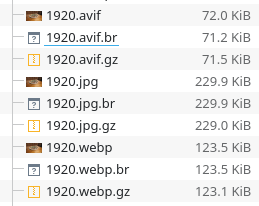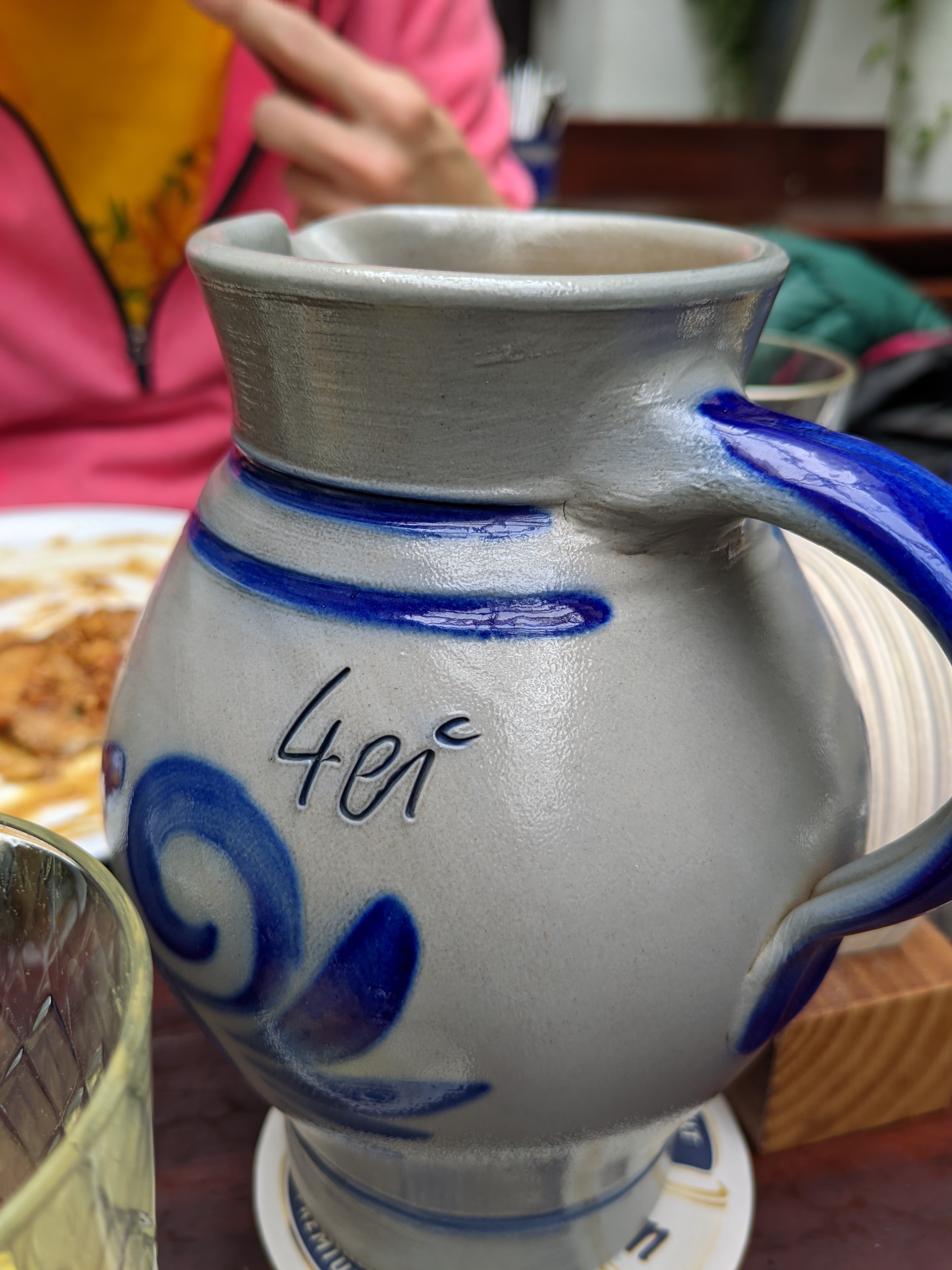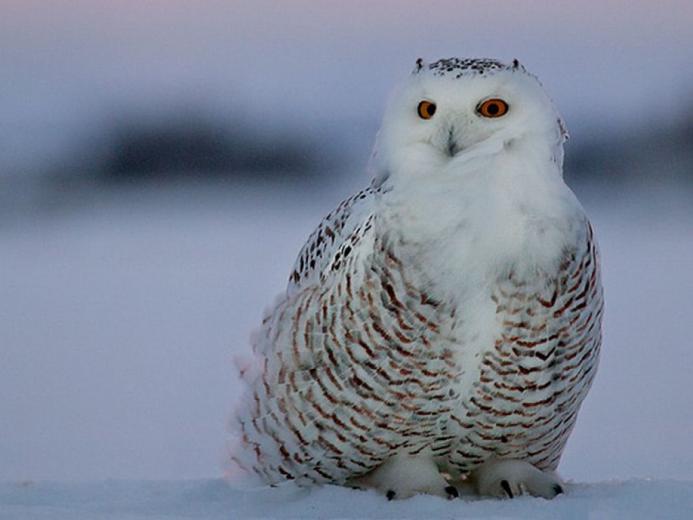- cross-posted to:
- [email protected]
- cross-posted to:
- [email protected]
Tbh, for myself I either want lossless (eg. professional photographs for an app) or don’t care about size, due to small volume (eg. my own pics and vids) and also kinda want the originals. And in today’s time, bandwidth isn’t lacking (for most people, including me). So everything’s just a png.
Oooh baby I like RAW
As is in the name, the format is meant for web.
The real difference is between gif and animated webp… Even fewer places accept animated webp than normal webp and those that do often don’t even show it right (looking at you slack emojis) which is a travesty as the file size difference is huge
I love webp though
That is because you are ignorant.
wrong
Just change the file extension to *.png. Works every time.
surprised_pikachu.webp.png
Wait till you find out what’s inside when you change Office files from .***x to .zip
Why does this even work though? WEBP and PNG are very different file formats yet for some reason this has always worked for me as well. Is windows automatically converting the files? I haven’t checked if changing the file extension changes the file size.
WebP is an extended container around the RIFF file format, and contains the RIFF header info. So any container that is built off RIFF, or supports RIFF, can at least interpret the container data that is RIFF compatible and will lose anything that has been extended upon.
Unironically it will work as @[email protected] and a bunch just like him has put in the work to Just WorkTM
Now try to find somewhere which accepts apng or mng. I’ll wait. ;)
Just checked, our very corporate and much antiquated website does accept apng (sadly not publicly visible as it’s b2b only). We do deal with photography though, so we do expect multitude of formats and mostly either pass them unchanged or just feed them to ImageMagick and forget about it. The bane of our existence is mostly DNG which Adobe breaks every year or so by introducing breaking spec changes.
EDIT: Haven’t found a place to even get an mng sample, though. Do you have any?
MNG is a bit of an oddity; it was originally supposed to replace GIF but was itself replaced with PNG, Flash, and SVG. I have no such files available but ImageMagick can supposedly make one out of a number of PNG or JPG files if you’re interested in toying with it.
I have never heard of those formats.
My point exactly.
Just don’t let Google kill JPEG XL.
The funniest thing is that even some of Google’s own products don’t accept Webp, like Google Voice.
Shhhh just be happy Google Voice still exists, and isn’t in the graveyard. Personally I’d take RCS over webp in Google Voice.
I feel with you. The product idea is awesome, the implementation is so-so, and progress is backwards. It’s heart-breaking, really, and so sad nobody has a real alternative.
“It works just like regular image formats, but it’s fun.”
What is being implied here? That Website A encourages you to download an image from them in WEBP format, but you cannot then upload that image to Websites B through Z because those sites do not support WEBP?
Here’s the original clip from The Simpsons episode: https://www.youtube.com/watch?v=g4XZxHXSHko
Not just websites, but software as well. Like image editing software. Which is quite bad.
Yes
I’m working on a project which generates images in multiples sizes, and also converts to WEBP and AVIF.
The difference in file size is significant. It might not matter to you, but it matters to a lot of people.
Here’s an example (the filename is the width):

Also, using the
<picture></picture>element, if the users’ browsers don’t support (or block) AVIF/WEBP, the original format is used. No harm in using them.(I know this is a meme post, but some people are taking it seriously)
How is the size difference after gzip compression? Probably pretty much the same, but I wonder how large the difference is then. Since a lot of folk make sure the contents is gzipped when served to the user.
Even using the highest compression levels, barely any difference. Not worth it

If I understand correctly gzip, brotli and similar are best used to compress text.
Font files also shouldn’t be compressed. A TTF file compresses a bit, but a WOFF2 file will be even smaller than that (and WOFF2 also doesn’t compress well). So might as well use WOFF/WOFF2
If I understand correctly gzip, brotli and similar are best used to compress text.
Compression algos should be used on uncompressed data. Using them on already compressed data (most video, images, music formats) is generally useless.
Thanks, very interesting results
I’m mad tho! I have technical issues with a format that works for hundreds of millions of users daily with the only impact being their website loads faster! RAGE!
But why webp over jxl
We already have the solution
Because jxl is a bunch of bollocks. There’s no way it will gain any support any time soon.
Webp is supported in browsers. Jxl is not, unfortunately.
(Well, I have the Firefox extension for it, but most people can’t see them…)
People should still use it tho, with the fallback of webp or avif
Firefox just hasn’t enabled the setting (well they haven’t made the setting enable jxl support yet even though the setting and support has been there for years). This means their forks support it, that’s why I switched to Waterfox
Safari supports it
Chromium removed support for it 2 years ago to push webp but it’s just a reminder to not use Chromium browsers
Just use jxl; it is better and not created by shitty googol.
I’ve mentioned this topic in regards to animated images, but don’t see as big a reason to push for static formats due to the overall relatively limited benefits other than wider gamut and marginally smaller file size (percentage wise they are significant, but 2KB vs 200KB is paltry on even a terrible connection in the 2000s).
What I really wish is that we could get more browsers, sites, and apps to universally support more modern formats to replace the overly bloated terribly performing and never correctly pronounced animated formats like GIF with something else like AVIF, webm, webp (this was a roughly ~60MB GIF, and becomes a 1MB WEBP with better performance), or even something like APNG…
Besides wider gamut, and better performance, the sizes are actually significant on all but the fastest connections and save sites on both storage and bandwidth at significant scale compared to the mere KB of change that a static modern asset has.
This WEBP is only 800KB but only shows up on some server instances since not every Lemmy host supports embedding them :

but 2KB vs 200KB is paltry on even a terrible connection in the 2000s).
You still need to resize the images and choose the right ones (even if only for the device’s performance).
So we might as well do that small extra step and add conversion to the process.
What I really wish is that we could get more browsers, sites, and apps to universally support more modern formats to replace the overly bloated terribly performing and never correctly pronounced animated formats like GIF with something else like AVIF, webm, webp (this was a roughly ~60MB GIF, and becomes a 1MB WEBP with better performance), or even something like APNG…
Isn’t that the users’ fault? And of the websites for allowing those huge GIFs.
Apparently browsers have supported MP4 for a long time.
How are you auto converting images to webp?? What is this magic. My company uses Visual Studio 2022 and our creative guy is having to save everything manually in multiple formats. Then our devs put in the webp first with a jpeg fallback, but it’s all so manual.
Funny you call it magic, what actually does the conversion is Imagick.
In my project I have it integrated in the upload process. You upload a PNG/JPG and it does its thing. Since it’s written in PHP (my project), and PHP has an extension to call Imagick, I didn’t need to write any complicated code.
You can see on this page if your programming language of choice has any integration with Imagick.
But there’s always the command line interface. Depending on your process it may be easier to create a script to “convert all images in a folder”, for example.
Very cool. Thanks for sharing!
It’s pronounced GIF
Is that last webp animated? Asking because I know jerboa (Lemmy client) doesn’t play animated images
Yea, it’s animated for me on a web client. Looks quite good tbh.
It’s animated for me using Thunder
Literally just today solved a problem of delivering analytics plots over our internal chat system. The file size limit is 28Kb and I was just getting ready to say screw it, can’t be done.
Lo and behold our chat system that doesn’t support svg does support webp. Even visually complicated charts come in just below the size limit with webp.
Why 28Kb though?
Honestly no idea. It’s funny though. The API allows us to either read it directly from our lakehouse with the 28Kb limit, or allows us to encode it in a json object. It actually recommends using the json method if we want to send larger files… but then complains it’s too large if it’s over 28Kb 🤷♂️
I think it was probably originally only intended to allow attaching icons.
Feels like a bug where someone forgot the 1 in 128kb. What chat app is this?? In Slack, custom emojis can be up to 128kb in filesize
It’s apparently PowerAutomate Adaptive cards.
It’s MS Teams with their PowerAutomate flows from Fabric. The limitation might not exist in the direct rest API, which I could have used through Python; but it’s a hackathon, and my other team mates know PowerAutomate. Faster if we each coordinate using what we’re good with.
Is the quality the same? If so how do you know? I mean it’s better, I’m just curious.
Tldr: as we deal with a problem long enough we find more effective ways of dealing with it
Has some info on what it does
https://en.m.wikipedia.org/wiki/JPEG_XL
Technically details might be more what you are looking for
https://jpegxl.info/resources/jpeg-xl-test-page
And a test page, if you don’t see jxl images then you should look at updating your browser
So you have no hard proof (no critic here, I’m just curious)? Not that it’s better but that your test images has the same quality.
For the rest, thank you for the links and the time but that only explains how the compression works.
If you want to know you could do fourier transform and see which kind of signals are cut out in one for example.
Quality improvements are that you can upload/download it without getting artifacts/pixel bleeding. JXL’s algorithm ensures that it’s a 1 to 1 transfer
But if I draw a stick person 512x512, there isn’t an image format that will make it anymore than it is. That’s why we look at compression
You mean there are no longer the 8x8 jpeg “boxes”?
There are no browsers with jxl support and won’t be for many years to come.
For most of the images that I tried you can only see differences with the images side by side. It’s really subtle.
I do have one example for which my config must be bad, compresses a lot but introduces a lot of noise
I don’t know if the client is the issue, but I am using the Voyager android app and this image failed to load
Works for me with Voyager on mobile.
No webp for me, just because Google is pushig it and that is suspect.
Lol it’s like 10 years old at this point. Not sure they’re pushing it anymore. I think files that are half the size sell themselves
Stop trying to make .webp happen. It’s not going to happen.
Maybe we should try to make it happen harder
They use it on their server side to save data, they don’t give a rip if we don’t use it. If they wanted us to use it, they’d have cancelled it already.
this post is so git fetch https://github.com/webmproject/libwebp
It’s already happened.
Found the Google guy
Tap for spoiler
/s
Doesn’t matter who made the format, it’s already widespread.
.jxl is the better image format anyway
And it’s not even a contest.
BTW, I only found out recently and by accident that my stock Gimp 2.10 supports it!Dude update your GIMP
.jxl is still early. Webp is out for 14 years now and if support is missing its completely on the ineptitude of the client and nothing else.
I feel like jxl is supported even less than webp though
webp is completely supported by browsers I think now.
Websites still get weird about it.
JXL is supported by Safari and ummmmm mobile Safari.
“Surely they must be exaggerating,” I thought…
webp is not fully supported by safari and webview on iOS; they cannot export images as image/webp using the toDataUrl or toBlob from a canvas element
Frak Safari.
iPhone 16 supports shooting in JPEG-XL and I expect that will be huge for hardware/processing adoption.
Too bad it’s being actively killed by Google. :(
Yeah, man, gotta use mozjpeg.
As someone who sometimes needs a quick and dirty stock image for my work, webp is the bane of my existence. The work computers won’t let me visit sites or install programs/extensions to convert the image, and my document processing programs have no fucking clue what to do with the format. There is an option in Microsoft edge to edit image, and it will dump the result as a .png which is the only workaround I’ve found.
Samir ?

They clearly hate printers, a safe assumption.
I had a colleague code a FFT algorithm in Excel because that was the only deployment tool the customer would be allowed to use…
loled at how the name of the Chinese guy is just “generic Chinese name” put into Google Translate
Personal homepage is HTML 2.0 compliant - gold (and it keeps giving, too)
Great content from ages ago
I run Firefox portable with the extension “Save webp as PNG or JPEG”. It has a button to copy directly to clipboard in the format of your choice.
So much this. I’ve completely forgotten about this issue since I’ve installed that extension.
I usually open it in paint and save as.
I usually screenshot it in place with alt-print screen, paste it into paint, crop it to size, and save
When I save as an image and it comes up as webp I just change the extension dropdown to all files and change the extension to .png in the filename box, hasn’t failed for me yet
Does that actually change the file, or will it still break when your software can’t handle webp? Because I did that to a webp, but Firefox still shows it’s a webp (in the tab name), probably based on magic byte. I don’t have any viewers that can’t display webp though, and I think they’re all smart enough to go by magic byte.























